英语语言学概论会话含义.合作原则.翁京京
- 格式:ppt
- 大小:633.00 KB
- 文档页数:14
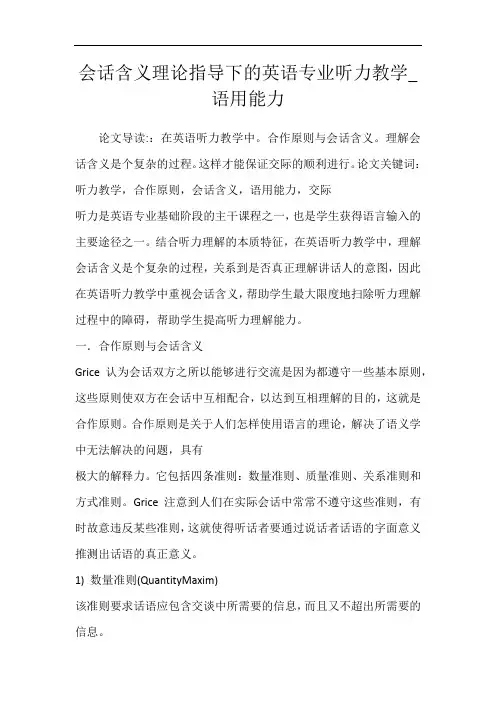
会话含义理论指导下的英语专业听力教学_语用能力论文导读::在英语听力教学中。
合作原则与会话含义。
理解会话含义是个复杂的过程。
这样才能保证交际的顺利进行。
论文关键词:听力教学,合作原则,会话含义,语用能力,交际听力是英语专业基础阶段的主干课程之一,也是学生获得语言输入的主要途径之一。
结合听力理解的本质特征,在英语听力教学中,理解会话含义是个复杂的过程,关系到是否真正理解讲话人的意图,因此在英语听力教学中重视会话含义,帮助学生最大限度地扫除听力理解过程中的障碍,帮助学生提高听力理解能力。
一.合作原则与会话含义Grice认为会话双方之所以能够进行交流是因为都遵守一些基本原则,这些原则使双方在会话中互相配合,以达到互相理解的目的,这就是合作原则。
合作原则是关于人们怎样使用语言的理论,解决了语义学中无法解决的问题,具有极大的解释力。
它包括四条准则:数量准则、质量准则、关系准则和方式准则。
Grice注意到人们在实际会话中常常不遵守这些准则,有时故意违反某些准则,这就使得听话者要通过说话者话语的字面意义推测出话语的真正意义。
1) 数量准则(QuantityMaxim)该准则要求话语应包含交谈中所需要的信息,而且又不超出所需要的信息。
例1.A:Where’veyou been?B:Out.B的回答过于简单。
他故意违反数量准则,想让对方感到他不愿意详细作答,隐含着“我去哪里与你无关”、“别多管闲事”等意思。
2).质量准则(Quality Maxim):努力使你所说的话是真实的。
a)不要说自知是虚假的话;b)不要说缺乏足够证据的话。
例2:W:Whatdo you think of Rose?M:She is a butterfly.从表面上看语用能力,女士说Rose是只蝴蝶核心期刊目录。
实际上,这是一个隐喻,女士并非说Rose是只蝴蝶,而是喻指他的举动轻浮如同蝴蝶.可见会话中出现的某些修辞手段,是对质准则的违反。
3).关联(Relation Maxim):要求话语内容要切题,要有关联。
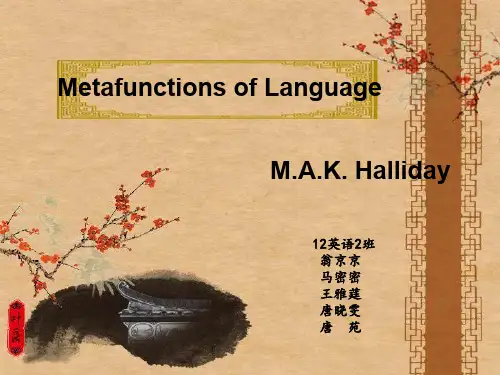
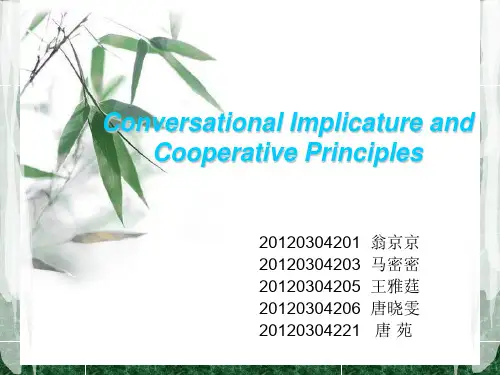
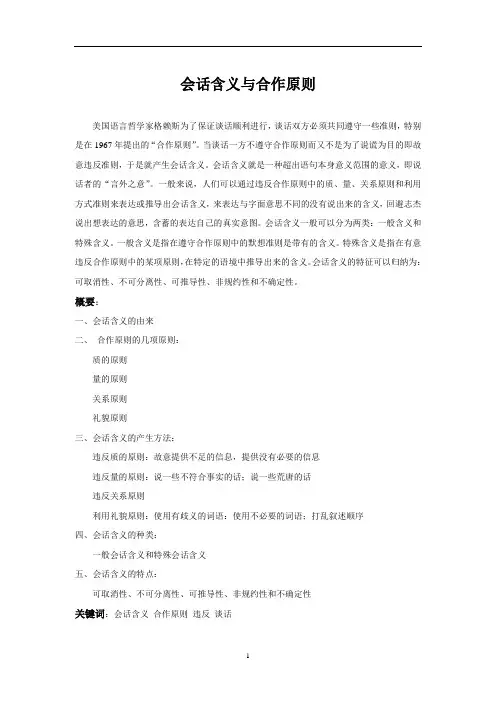
会话含义与合作原则美国语言哲学家格赖斯为了保证谈话顺利进行,谈话双方必须共同遵守一些准则,特别是在1967年提出的“合作原则”。
当谈话一方不遵守合作原则而又不是为了说谎为目的即故意违反准则,于是就产生会话含义。
会话含义就是一种超出语句本身意义范围的意义,即说话者的“言外之意”。
一般来说,人们可以通过违反合作原则中的质、量、关系原则和利用方式准则来表达或推导出会话含义,来表达与字面意思不同的没有说出来的含义,回避志杰说出想表达的意思,含蓄的表达自己的真实意图。
会话含义一般可以分为两类:一般含义和特殊含义。
一般含义是指在遵守合作原则中的默想准则是带有的含义。
特殊含义是指在有意违反合作原则中的某项原则,在特定的语境中推导出来的含义。
会话含义的特征可以归纳为:可取消性、不可分离性、可推导性、非规约性和不确定性。
概要:一、会话含义的由来二、合作原则的几项原则:质的原则量的原则关系原则礼貌原则三、会话含义的产生方法:违反质的原则:故意提供不足的信息,提供没有必要的信息违反量的原则:说一些不符合事实的话;说一些荒唐的话违反关系原则利用礼貌原则:使用有歧义的词语:使用不必要的词语;打乱叙述顺序四、会话含义的种类:一般会话含义和特殊会话含义五、会话含义的特点:可取消性、不可分离性、可推导性、非规约性和不确定性关键词:会话含义合作原则违反谈话C onversational Implicature and Cooperative PrincipleAmerican linguistics H.P.Grice once gave in 1967.In the speech, Grice said, the two sides of the conversation must obey some basic rules, especially the “cooperative principle”, to ensure that the conversation can go on propitiously. When one side of the principle doesn’t want to lie, conversational implicature comes out. Conversational implicature is a kind of meaning, which is beyond the sentence itself. Generally speaking, people can violate the maxim of quality, quantity, and relation and use the maxim of the manner to produce conversational implicature, which send the unsaid meaning of the words. Generally speaking, conversational implicature can be divided into two kinds: generalized implicature and particularized implicature. Generalized implcature refers to an implicature, which obeys the cooperative principle and also has the meaning. Particularized implicature refers to the implicature that violates some of the cooperative principle and makes the meaning in some specially context. The features of the conversational implicature: cancelability, no detachability, calculability, non-conventionality and indeterminacy:Key words:Conversational implicature cooperative principle violate conversationC onversational Implicature and Cooperative PrincipleAmerican linguistics H.P.Grice once gave speeches in 1967.In the speech. Grice said, the two sides of the conversation must obey some basic rules, especially the “cooperative principle”,to ensure that the conversation can go on propitiously. He believed the two sides of the conversation should have a same wish: the two sides can understand each other. So both of them obey some cooperative principles to achieve the aim. However, Grice said, not all the people in the conversation obey the rules. Once one side finds the other side not obey the cooperative principle, he will make himself try his best to understand the unsaid meaning in the conversation. So the conversational implicature comes out.As the conversational implicature has a close relationship with the co operational principle, we will introduce the cooperative principle first. In a conversation, the participants must first of all be willing to cooperate;Otherwise, it would not be possible for them to carry on the talk. This general principle is called the cooperative principle.There are four main maxims in the cooperative principle:●The maxim of quality: make your contribution as informative as required(for thecurrent purpose of the exchange);Do not make your contribution more informative than is required.●The maxim of quality: do not say what you believe to be false; do not say that forwhich you back adequate evidence.●The maxim of relation: the words have a relationship with other factors.The maxim of manner: avoid obscurity of expression; avoid ambiguity; be brief (avoid unnecessary prolixity); be orderly.The conversational implicature is a meaning out of the sentence itself; it is the speaker’s meaning under the literal. In the real life, people often violate some principles to sent some dark meaning.The meaning related with the cooperative principle may become by the following ways:First, to violate the maxim of quality1.Offer the deficient information on purpose.E.g.:One farmer meets Sam and says:“Hey, Sam, my horse’s got distemper. What did you give yours hen he had it?”“Turpentine,” grunted Sam.A week later they meet again and the first farmer shouts:“Sam, I gave my horse turpentine like you said and it killed him.”“S o did mine.” nodded Sam.第一位农妇的真正目的不仅是向Sam了解马病用了什么药,而且想了解治疗的结果,但通过对话它实际上只达到了一半的目标。
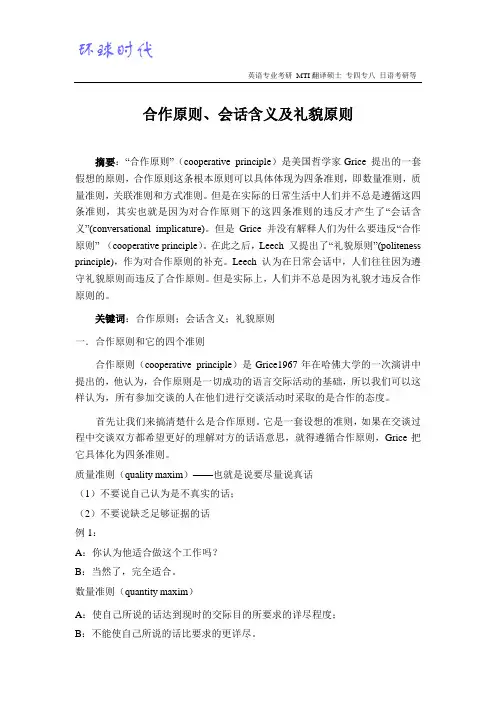
合作原则、会话含义及礼貌原则摘要:“合作原则”(cooperative principle)是美国哲学家Grice 提出的一套假想的原则,合作原则这条根本原则可以具体体现为四条准则,即数量准则,质量准则,关联准则和方式准则。
但是在实际的日常生活中人们并不总是遵循这四条准则,其实也就是因为对合作原则下的这四条准则的违反才产生了“会话含义”(conversational implicature)。
但是Grice 并没有解释人们为什么要违反“合作原则” (cooperative principle)。
在此之后,Leech 又提出了“礼貌原则”(politeness principle),作为对合作原则的补充。
Leech 认为在日常会话中,人们往往因为遵守礼貌原则而违反了合作原则。
但是实际上,人们并不总是因为礼貌才违反合作原则的。
关键词:合作原则;会话含义;礼貌原则一.合作原则和它的四个准则合作原则(cooperative principle)是Grice1967年在哈佛大学的一次演讲中提出的,他认为,合作原则是一切成功的语言交际活动的基础,所以我们可以这样认为,所有参加交谈的人在他们进行交谈活动时采取的是合作的态度。
首先让我们来搞清楚什么是合作原则。
它是一套设想的准则,如果在交谈过程中交谈双方都希望更好的理解对方的话语意思,就得遵循合作原则,Grice把它具体化为四条准则。
质量准则(quality maxim)——也就是说要尽量说真话(1)不要说自己认为是不真实的话;(2)不要说缺乏足够证据的话例1:A:你认为他适合做这个工作吗?B:当然了,完全适合。
数量准则(quantity maxim)A:使自己所说的话达到现时的交际目的所要求的详尽程度;B:不能使自己所说的话比要求的更详尽。
也就是说,数量准则规定,我们向对方传递的信息只能是对方想得到的,不能多也不能少,不要说对方不想听到的。
例2:A:这学期你修了几门课程?B:五门。
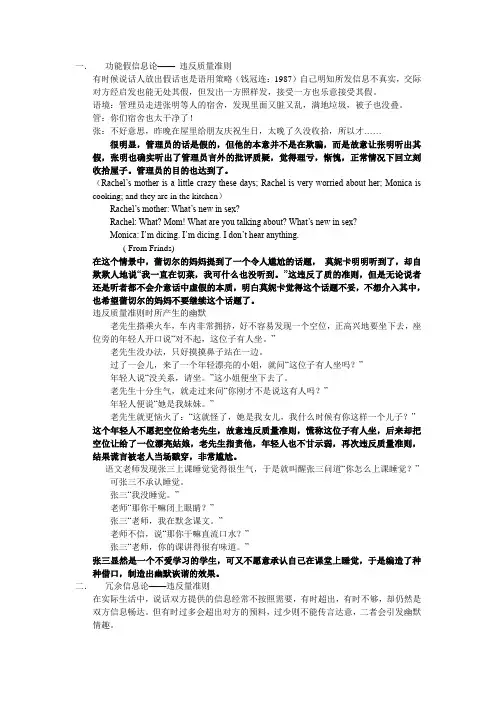
一.功能假信息论——违反质量准则有时候说话人放出假话也是语用策略(钱冠连:1987)自己明知所发信息不真实,交际对方经启发也能无处其假,但发出一方照样发,接受一方也乐意接受其假。
语境:管理员走进张明等人的宿舍,发现里面又脏又乱,满地垃圾,被子也没叠。
管:你们宿舍也太干净了!张:不好意思,昨晚在屋里给朋友庆祝生日,太晚了久没收拾,所以才……很明显,管理员的话是假的,但他的本意并不是在欺骗,而是故意让张明听出其假,张明也确实听出了管理员言外的批评质疑,觉得理亏,惭愧,正常情况下回立刻收拾屋子。
管理员的目的也达到了。
(Rachel’s mother is a little crazy these days; Rachel is very worried about her; Monica is cooking; and they are in the kitchen)Rachel’s mother: What’s new in sex?Rachel: What? Mom! What are you talking about? What’s new in sex?Monica: I’m dicing. I’m dicing. I don’t hear anything.( From Frinds)在这个情景中,蕾切尔的妈妈提到了一个令人尴尬的话题,莫妮卡明明听到了,却自欺欺人地说“我一直在切菜,我可什么也没听到。
”这违反了质的准则,但是无论说者还是听者都不会介意话中虚假的本质,明白莫妮卡觉得这个话题不妥,不想介入其中,也希望蕾切尔的妈妈不要继续这个话题了。
违反质量准则时所产生的幽默老先生搭乘火车,车内非常拥挤,好不容易发现一个空位,正高兴地要坐下去,座位旁的年轻人开口说“对不起,这位子有人坐。
”老先生没办法,只好摸摸鼻子站在一边。
过了一会儿,来了一个年轻漂亮的小姐,就问“这位子有人坐吗?”年轻人说“没关系,请坐。
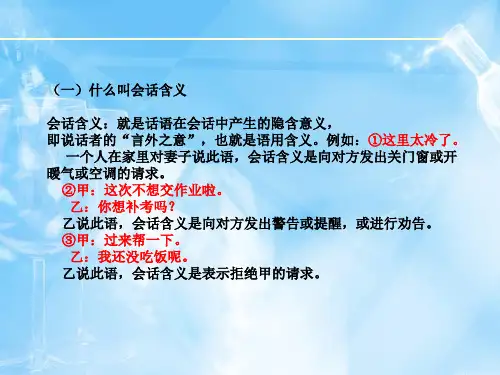
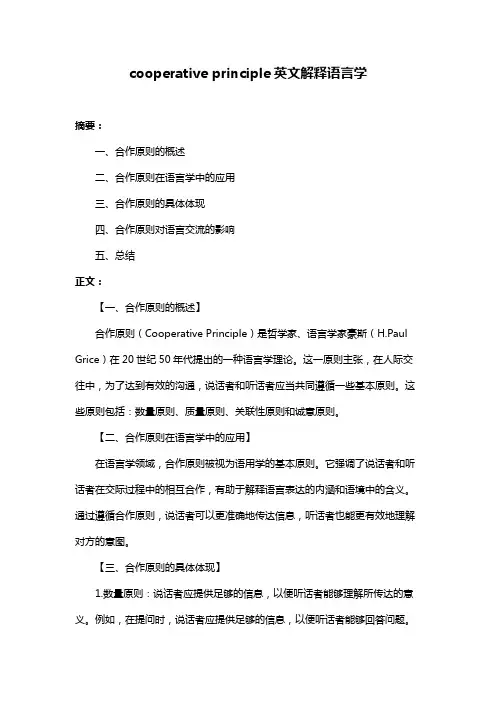
cooperative principle英文解释语言学摘要:一、合作原则的概述二、合作原则在语言学中的应用三、合作原则的具体体现四、合作原则对语言交流的影响五、总结正文:【一、合作原则的概述】合作原则(Cooperative Principle)是哲学家、语言学家豪斯(H.Paul Grice)在20世纪50年代提出的一种语言学理论。
这一原则主张,在人际交往中,为了达到有效的沟通,说话者和听话者应当共同遵循一些基本原则。
这些原则包括:数量原则、质量原则、关联性原则和诚意原则。
【二、合作原则在语言学中的应用】在语言学领域,合作原则被视为语用学的基本原则。
它强调了说话者和听话者在交际过程中的相互合作,有助于解释语言表达的内涵和语境中的含义。
通过遵循合作原则,说话者可以更准确地传达信息,听话者也能更有效地理解对方的意图。
【三、合作原则的具体体现】1.数量原则:说话者应提供足够的信息,以便听话者能够理解所传达的意义。
例如,在提问时,说话者应提供足够的信息,以便听话者能够回答问题。
2.质量原则:说话者应确保传达的信息是真实的、准确的和有根据的。
例如,在陈述事实时,说话者应确保所提供的信息是可靠的。
3.关联性原则:说话者的言语应与当前语境相关。
例如,在对话中,说话者应确保自己的发言与之前的谈话内容有关。
4.诚意原则:说话者应表现出诚意,避免误导听话者。
例如,在表达意见时,说话者应表明自己的观点,而不是故意误导对方。
【四、合作原则对语言交流的影响】合作原则对语言交流具有重要的影响。
遵循这一原则,说话者和听话者能够更好地理解对方的意图,减少误解和沟通障碍。
此外,合作原则还有助于提高语言表达的准确性和有效性,促进人际关系的和谐。
【五、总结】总之,合作原则是语言学领域的一个重要理论,对于解释人际交往中的语言现象具有重要的指导意义。
通过遵循合作原则,说话者和听话者能够实现更有效的沟通,提高语言交流的质量和效率。
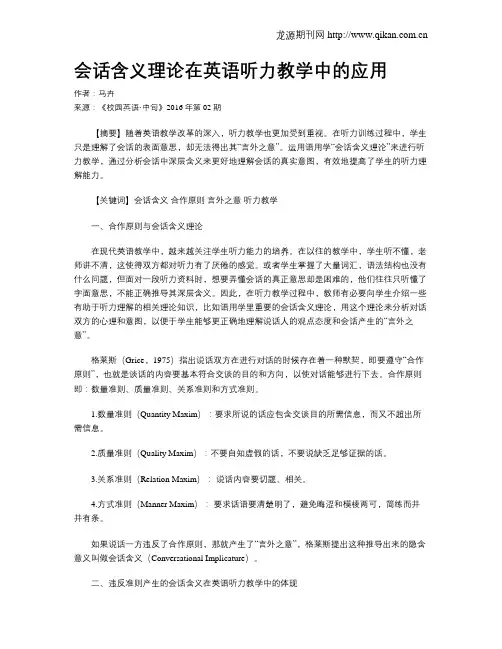
会话含义理论在英语听力教学中的应用作者:马卉来源:《校园英语·中旬》2016年第02期【摘要】随着英语教学改革的深入,听力教学也更加受到重视。
在听力训练过程中,学生只是理解了会话的表面意思,却无法得出其“言外之意”。
运用语用学“会话含义理论”来进行听力教学,通过分析会话中深层含义来更好地理解会话的真实意图,有效地提高了学生的听力理解能力。
【关键词】会话含义合作原则言外之意听力教学一、合作原则与会话含义理论在现代英语教学中,越来越关注学生听力能力的培养。
在以往的教学中,学生听不懂,老师讲不清,这使得双方都对听力有了厌倦的感觉。
或者学生掌握了大量词汇,语法结构也没有什么问题,但面对一段听力资料时,想要弄懂会话的真正意思却是困难的,他们往往只听懂了字面意思,不能正确推导其深层含义。
因此,在听力教学过程中,教师有必要向学生介绍一些有助于听力理解的相关理论知识,比如语用学里重要的会话含义理论,用这个理论来分析对话双方的心理和意图,以便于学生能够更正确地理解说话人的观点态度和会话产生的“言外之意”。
格莱斯(Grice,1975)指出说话双方在进行对话的时候存在着一种默契,即要遵守“合作原则”,也就是谈话的内容要基本符合交谈的目的和方向,以使对话能够进行下去。
合作原则即:数量准则、质量准则、关系准则和方式准则。
1.数量准则(Quantity Maxim):要求所说的话应包含交谈目的所需信息,而又不超出所需信息。
2.质量准则(Quality Maxim):不要自知虚假的话,不要说缺乏足够证据的话。
3.关系准则(Relation Maxim):说话内容要切题、相关。
4.方式准则(Manner Maxim):要求话语要清楚明了,避免晦涩和模棱两可,简练而井井有条。
如果说话一方违反了合作原则,那就产生了“言外之意”,格莱斯提出这种推导出来的隐含意义叫做会话含义(Conversational Implicature)。
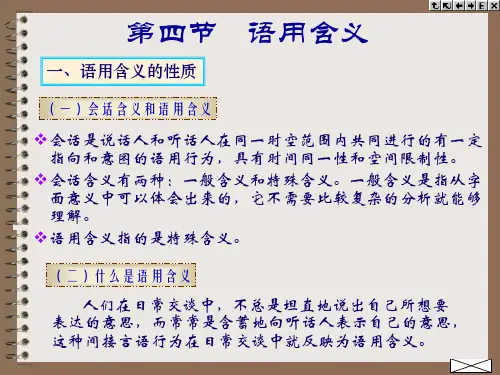
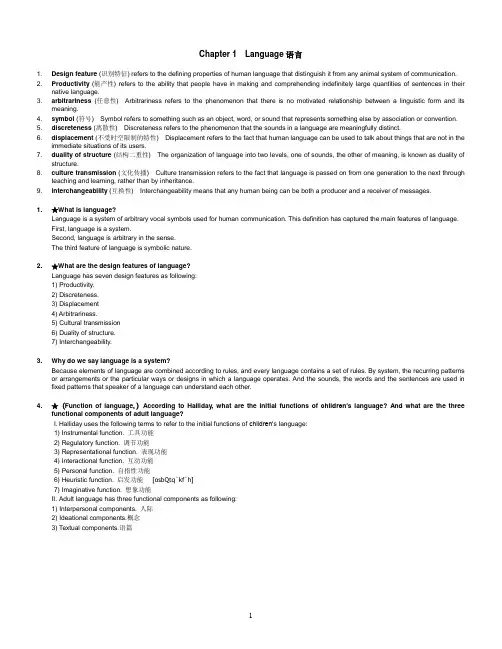
Chapter 1 Language语言1. Design feature (识别特征) refers to the defining properties of human language that distinguish it from any animal system of communication.2. Productivity(能产性) refers to the ability that people have in making and comprehending indefinitely large quantities of sentences in theirnative language.3. arbitrariness (任意性) Arbitrariness refers to the phenomenon that there is no motivated relationship between a linguistic form and itsmeaning.4. symbol (符号) Symbol refers to something such as an object, word, or sound that represents something else by association or convention.5. discreteness (离散性) Discreteness refers to the phenomenon that the sounds in a language are meaningfully distinct.6. displacement (不受时空限制的特性) Displacement refers to the fact that human language can be used to talk about things that are not in theimmediate situations of its users.7. duality of structure (结构二重性) The organization of language into two levels, one of sounds, the other of meaning, is known as duality ofstructure.8. culture transmission (文化传播) Culture transmission refers to the fact that language is passed on from one generation to the next throughteaching and learning, rather than by inheritance.9. interchangeability (互换性) Interchangeability means that any human being can be both a producer and a receiver of messages.1. ★What is language?Language is a system of arbitrary vocal symbols used for human communication. This definition has captured the main features of language.First, language is a system.Second, language is arbitrary in the sense.The third feature of language is symbolic nature.2. ★What are the design features of language?Language has seven design features as following:1) Productivity.2) Discreteness.3) Displacement4) Arbitrariness.5) Cultural transmission6) Duality of structure.7) Interchangeability.3. Why do we say language is a system?Because elements of language are combined according to rules, and every language contains a set of rules. By system, the recurring patterns or arrangements or the particular ways or designs in which a language operates. And the sounds, the words and the sentences are used in fixed patterns that speaker of a language can understand each other.4. ★ (Function of language.) According to Halliday, what are the initial functions of children’s language? And what are the threefunctional components of adult language?I. Halliday uses the following terms to refer to the initial functions of children’s language:1) Instrumental function. 工具功能2) Regulatory function. 调节功能3) Representational function. 表现功能4) Interactional function. 互动功能5) Personal function. 自指性功能6) Heuristic function. 启发功能[osbQtq`kf`h]7) Imaginative function. 想象功能II. Adult language has three functional components as following:1) Interpersonal components. 人际2) Ideational components.概念3) Textual components.语篇1. general linguistics and descriptive linguistics (普通语言学与描写语言学) The former deals with language in general whereas the latter isconcerned with one particular language.2. synchronic linguistics and diachronic linguistics (共时语言学与历时语言学) Diachronic linguistics traces the historical development of thelanguage and records the changes that have taken place in it between successive points in time. And synchronic linguistics presents an account of language as it is at some particular point in time.3. theoretical linguistics and applied linguistics (理论语言学与应用语言学) The former copes with languages with a view to establishing atheory of their structures and functions whereas the latter is concerned with the application of the concepts and findings of linguistics to all sorts of practical tasks.4. microlinguistics and macrolinguistics(微观语言学与宏观语言学) The former studies only the structure of language system whereas thelatter deals with everything that is related to languages.5. langue and parole (语言与言语) The former refers to the abstract linguistics system shared by all the members of a speech communitywhereas the latter refers to the concrete act of speaking in actual situation by an individual speaker.6. competence and performance (语言能力与语言运用) The former is one’s knowledge of all the linguistic regulation systems whereas the latteris the use of language in concrete situation.7. speech and writing (口头语与书面语) Speech is the spoken form of language whereas writing is written codes, gives language new scope.8. linguistics behavior potential and actual linguistic behavior (语言行为潜势与实际语言行为) People actually says on a certain occasion to acertain person is actual linguistics behavior. And each of possible linguistic items that he could have said is linguistic behavior potential.9. syntagmatic relation and paradigmatic relation(横组合关系与纵聚合关系) The former describes the horizontal dimension of a languagewhile the latter describes the vertical dimension of a language.10. verbal communication and non-verbal communication(言语交际与非言语交际) Usual use of language as a means of transmittinginformation is called verbal communication. The ways we convey meaning without using language is called non-verbal communication.1. ★How does John Lyons classify linguistics?According to John Lyons, the field of linguistics as a whole can be divided into several subfields as following:1) General linguistics and descriptive linguistics.2) Synchronic linguistics and diachronic linguistics.3) Theoretical linguistics and applied linguistics.4) Microlinguistics and macrolinguistics.2. Explain the three principles by which the linguist is guided: consistency, adequacy and simplicity.1) Consistency means that there should be no contradictions between different parts of the theory and the description.2) Adequacy means that the theory must be broad enough in scope to offer significant generalizations.3) Simplicity requires us to be as brief and economic as possible.3. ★What are the sub-branches of linguistics within the language system?Within the language system there are six sub-branches as following:1) Phonetics. 语音学is a study of speech sounds of all human languages.2) Phonology. 音位学studies about the sounds and sound patterns of a speaker’s native language.3) Morphology. 形态学studies about how a word is formed.4) Syntax. 句法学studies about whether a sentence is grammatical or not.5) Semantics. 语义学studies about the meaning of language, including meaning of words and meaning of sentences.6) Pragmatics. 语用学★The scope of language: Linguistics is referred to as a scientific study of language.★The scientific process of linguistic study: It involves four stages: collecting data, forming a hypothesis, testing the hypothesis and drawing conclusions.1. articulatory phonetics(发音语音学) The study of how speech organs produce the sounds is called articulatory phonetics.2. acoustic phonetics (声学语音学) The study of the physical properties and of the transmission of speech sounds is called acoustic phonetics.3. auditory phonetics (听觉语音学) The study of the way hearers perceive speech sounds is called auditory phonetics.4. consonant (辅音) Consonant is a speech sound where the air form the language is either completely blocked, or partially blocked, or where theopening between the speech organs is so narrow that the air escapes with audible friction.5. vowel (元音) is defined as a speech sound in which the air from the lungs is not blocked in any way and is pronounced with vocal-cord vibration.6. bilabials (双唇音) Bilabials means that consonants for which the flow of air is stopped or restricted by the two lips. [p][b] [m] [w]7. affricates (塞擦音) The sound produced by stopping the airstream and then immediately releasing it slowly is called affricates. [t X] [d Y] [tr] [dr]8. glottis (声门) Glottis is the space between the vocal cords.9. rounded vowel (圆唇元音) Rounded vowel is defined as the vowel sound pronounced by the lips forming a circular opening. [u:] [u] [OB] [O]10. diphthongs (双元音) Diphthongs are produced by moving from one vowel position to another through intervening positions.[ei][ai][O i] [Q u][au]11. triphthongs(三合元音) Triphthongs are those which are produced by moving from one vowel position to another and then rapidly andcontinuously to a third one. [ei Q][ai Q][O i Q] [Q u Q][au Q]12. lax vowels (松元音) According to distinction of long and short vowels, vowels are classified tense vowels and lax vowels. All the long vowelsare tense vowels but of the short vowels,[e] is a tense vowel as well, and the rest short vowels are lax vowels.1. ★How are consonants classified in terms of different criteria?The consonants in English can be described in terms of four dimensions.1) The position of the soft palate.2) The presence or the absence of vocal-cord vibration.3) The place of articulation.4) The manner of articulation.2. ★How are vowels classified in terms of different criteria?Vowel sounds are differentiated by a number of factors.1) The state of the velum2) The position of the tongue.3) The openness of the mouth.4) The shape of the lips.5) The length of the vowels.6) The tension of the muscles at pharynx.3. ★What are the three sub-branches of phonetics? How do they differ from each other?Phonetics has three sub-branches as following:1) Articulatory phonetics is the study of how speech organs produce the sounds is called articulatory phonetics.2) Acoustic phonetics is the study of the physical properties and of the transmission of speech sounds is called acoustic phonetics.3) Auditory phonetics is the study of the way hearers perceive speech sounds is called auditory phonetics.4. ★What are the commonly used phonetic features for consonants and vowels respectively?I. The frequently used phonetic features for consonants include the following:1) Voiced.2) Nasal.3) Consonantal.4) Vocalic.5) Continuant.6) Anterior.7) Coronal.8) Aspirated.II. The most common phonetic features for vowels include the following:1) High.2) Low.3) Front.4) Back.5) Rounded.6) Tense.1. phonemes (音位) Phonemes are minimal distinctive units in the sound system of a language.2. allophones (音位变体) Allophones are the phonetic variants and realizations of a particular phoneme.3. phones (单音) The smallest identifiable phonetic unit found in a stream of speech is called a phone.4. minimal pair (最小对立体) Minimal pair means words which differ from each other only by one sound.5. contrastive distribution (对比分布) If two or more sounds can occur in the same environment and the substitution of one sound for anotherbrings about a change of meaning, they are said to be in contrastive distribution.6. complementary distribution(互补分布) If two or more sounds never appear in the same environment ,then they are said to be incomplementary distribution.7. free variation (自由变异) When two sounds can appear in the same environment and the substitution of one for the other does not cause anychange in meaning, then they are said to be in free variation.8. distinctive features (区别性特征) A distinctive feature is a feature which distinguishes one phoneme from another.9. suprasegmental features (超切分特征) The distinctive (phonological) features which apply to groups larger than the single segment are knownas suprasegmental features.10. tone languages (声调语言) Tone languages are those which use pitch to contrast meaning at word level.11. intonation languages (语调语言) Intonation languages are those which use pitch to distinguish meaning at phrase level or sentence level.12. juncture (连音) Juncture refers to the phonetic boundary features which may demarcate grammatical units.1. ★What are the differences between English phonetics and English phonology?1) Phonetics is the study of the production, perception, and physical properties of speech sounds, while phonology attempts to account forhow they are combined, organized, and convey meaning in particular languages.2) Phonetics is the study of the actual sounds while phonology is concerned with a more abstract description of speech sounds and tries todescribe the regularities of sound patterns.2. Give examples to illustrate the relationship between phonemes, phones and allophones.When we hear [pit],[tip],[spit],etc, the similar phones we have heard are /p/. And /p/ and /b/ are separate phonemes in English, while [ph] and [p] are allophones.3. How can we decide a minimal pair or a minimal set?A minimal pair should meet three conditions:1) The two forms are different in meaning.2) The two forms are different in one sound segment.3) The different sounds occur in the same position of the two strings.4. ★Use examples to explain the three types of distribution.1) Contrastive distribution. Sounds [m] in met and [n] in net are in contrastive distribution because substituting [m] for [n] will result in achange of meaning.2) Complementary distribution. The aspirated plosive [ph] and the unaspirated plosive [p] are in complementary distribution because theformer occurs either initially in a word or initially in a stressed syllable while the latter never occurs in such environments.3) Free variation. In English, the word “direct” may be pronounce in two ways: /di’rekt/ and /dia’rekt/, and the two different sounds /i/ and /ai/can be said to be in free variation.5. What’s the difference between segmental features and suprasegmental features? What are the suprasegmental features in English?I. 1) Distinctive features, which are used to distinguish one phoneme from another and thus have effect on one sound segment, are referred toas segmental features.2) The distinctive (phonological) features which apply to groups larger than the single segment are known as suprasegmental features.3) Suprasegmental features may have effect on more than one sound segment. They may apply to a string of several sounds.II.The main suprasegmental features include stress, tone, intonation and juncture.6. What’s the difference between tone languages and intonation language?Tone languages are those which use pitch to contrast meaning at word level while intonation languages are those which use pitch to distinguish meaning at phrase level or sentence level7. ★What’s the difference between phonetic transcriptions and phonemic transcriptions?The former was meant to symbolize all possible speech sounds, including even the most minute shades of pronunciation, while the latter was intended to indicate only those sounds capable of distinguishing one word from another in a given language.1. morphemes (语素) Morphemes are the minimal meaningful units in the grammatical system of a language.allomorphs (语素变体) Allomorphs are the realizations of a particular morpheme.morphs (形素) Morphs are the realizations of morphemes in general and are the actual forms used to realize morphemes.2. roots (词根) Roots is defined as the most important part of a word that carries the principal meaning.affixes (词缀) Affixes are morphemes that lexically depend on roots and do not convey the fundamental meaning of words.free morphemes (自由语素) Free morphemes are those which can exist as individual words.bound morphemes (粘着语素) Bound morphemes are those which cannot occur on their own as separate words.3. inflectional affixes (屈折词缀) refer to affixes that serve to indicate grammatical relations, but do not change its part of speech.derivational affixes (派生词缀) refer to affixes that are added to words in order to change its grammatical category or its meaning.4. empty morph (空语子) Empty morph means a morph which has form but no meaning.zero morph (零语子) Zero morph refers to a morph which has meaning but no form.5. IC Analysis (直接成分分析) IC analysis is the analysis to analyze a linguistic expression (both a word and a sentence) into a hierarchicallydefined series of constituents.6. immediate constituents(直接成分) A immediate constituent is any one of the largest grammatical units that constitute a construction.Immediate constituents are often further reducible.ultimate constituents (最后成分) Ultimate constituents are those grammatically irreducible units that constitute constructions.7. morphological rules (形态学规则) The principles that determine how morphemes are combined into new words are said to be morphologicalrules.8. word-formation process (构词法) Word-formation process mean the rule-governed processes of forming new words on the basis of alreadyexisting linguistic resources.1. ★What is IC Analysis?IC analysis is the analysis to analyze a linguistic expression (both a word and a sentence) into a hierarchically defined series of constituents.2. How are morphemes classified?1) Semantically speaking, morphemes are grouped into two categories: root morphemes and affixational morphemes.2) Structurally speaking, they are divided into two types: free morphemes and bound morphemes.3. ★Explain the interrelations between semantic and structural classifications of morphemes.a) All free morphemes are roots but not all roots are free morphemes.b) All affixes are bound morphemes, but not all bound morphemes are affixes.4. What’s the difference between an empty morph and a zero mor ph?a) Empty morph means a morph that has form but no meaning.b) Zero morph refers to a morph that has meaning but no form.5. Explain the differences between inflectional and derivational affixes in term of both function and position.a) Functionally:i.Inflectional affixes sever to mark grammatical relations and never create new words while derivational affixes can create new words.ii.Inflectional affixes do not cause a change in grammatical class while derivational affixes very often but not always cause a change in grammatical class.b) In term of position:i.Inflectional affixes are suffixes while derivational affixes can be suffixes or prefixes.ii.Inflectional affixes are always after derivational affixes if both are present. And derivational affixes are always before inflectional suffixes if both are present.6. What are morphological rules? Give at least four rules with examples.The principles that determine how morphemes are combined into new words are said to be morphological rules.For example:a) un- + adj. ->adj.b) Adj./n. + -ify ->v.c) V. + -able -> adj.d) Adj. + -ly -> adv.1. syntagmatic relations (横组关系) refer to the relationships between constituents in a construction.paradigmatic relations (纵聚合关系) refer to the relations between the linguistic elements within a sentence and those outside the sentence.hierarchical relations (等级关系) refer to relationships between any classification of linguistic units which recognizes a series of successively subordinate levels.2. IC Analysis (直接成分分析) is a kind of grammatical analysis, which make major divisions at any level within a syntactic construction.labeled IC Analysis(标记法直接成分分析) is a kind of grammatical analysis, which make major divisions at any level within a syntactic construction and label each constituent.phrase markers (短语标记法) is a kind of grammatical analysis, which make major divisions at any level within a syntactic construction, and label each constituent while remove all the linguistic forms.labeled bracketing (方括号标记法) is a kind of grammatical analysis, which is applied in representing the hierarchical structure of sentences by using brackets.3. constituency (成分关系)dependency (依存关系)4. surface structures (表层结构)refers to the mental representation of a linguistic expression, derived from deep structure by transformationalrules.deep structures (深层结构) deep structure of a linguistic expression is a theoretical construct that seeks to unify several related structures. 5. phrase structure rules (短语结构规则)are a way to describe a given language's syntax. They are used to break a natural language sentencedown into its constituent parts.6. transformational rules (转换规则)7. structural ambiguity (结构歧义)1. What are the differences between surface structure and deep structure?They are different from each other in four aspects:1) Surface structures correspond directly to the linear arrangements of sentences while deep structures correspond to the meaningful groupingof sentences.2) Surface structures are more concrete while deep structures are more abstract.3) Surface structures give the forms of sentences whereas deep structures give the meanings of sentences.4) Surface structures are pronounceable but deep structures are not.2. Illustrate the differences between PS rules and T-rules.1) PS rules frequently applied in generating deep structures.2) T-rules are used to transform deep structure into surface structures.3. What’s the order of generating sentences? Do we st art with surface structures or with deep structures? How differently are theygenerated?To generate a sentence, we always start with its deep structure, and then transform it into its corresponding surface structure.Deep structures are generated by phrase structure rules (PS rules) while surface structures are derived from their deep structures by transformational rules (T-rules).4. What’s the difference between a compulsory constituent and an optional one?Optional constituents may be present or absent while compulsory constituents must be present.5. What are the three syntactic relations? Illustrate them with examples.1) Syntagmatic relations2) Paradigmatic relations.3) Hierarchical relations.1. Lexical semantics (词汇语义学) is defined as the study of word meaning in language.2. Sense (意义) refers to the inherent meaning of the linguistic form.3. Reference (所指) means what a linguistic form refers to in the real world.4. Concept (概念) is the result of human cognition, reflecting the objective world in the human mind.5. Denotation (外延) is defined as the constant ,abstract, and basic meaning of a linguistic expression independent of context and situation.6. Connotation (内涵) refers to the emotional associations which are suggested by, or are part of the meaning of, a linguistic unit.7. Componential analysis (成分分析法) is the way to decompose the meaning of a word into its components.8. Semantic field (语义场) The vocabulary of a language is not simply a listing of independent items, but is organized into areas, within whichwords interrelate and define each other in various ways. The areas are semantic fields.9. Hyponymy (上下义关系) refers to the sense relation between a more general, more inclusive word and a more specific word.10. Synonymy (同义关系) refers to the sameness or close similarity of meaning.11. Antonymy (反义关系) refers to the oppositeness of meaning.12. Lexical ambiguity (词汇歧义)13. Polysemy (多义性) refers to the fact that the same one word may have more than one meaning.14. Homonymy (同音(同形)异义关系) refers to the phenomenon that words having different meanings have the same form.15. Sentence semantics (句子语义学) refers to the study of sentence meaning in language.1. What’s the criterion of John Lyons in classifying semantics into its sub-branches? And how does he classify semantics?In terms of whether it falls within the scope of linguistics, John Lyons distinguishes between linguistic semantics and non-linguistic semantics.According John Lyons, semantics is one of the sub-branches of linguistics; it is generally defined as the study of meaning.2. What are the essential factors for determining sentence meaning?1) Object, 2) concept, 3) symbol, 4) user, 5) context.3. What is the difference between the theory of componential analysis and the theory of semantic theory in defining meaning of words?4. What are the sense relations between sentences?1) S1 is synonymous with S2.2) S1 entails S2.3) S1 contradicts S2.4) S1 presupposes S2.5) S1 is a tautology, and therefore invariably true.6) S1 is a contradiction, and therefore invariably false.7) S1 is semantically anomalous.1. Speech act theory (言语行为理论)2. Cooperative principle and its maxims (合作原则及其准则)3. Politeness principle and its maxims (礼貌原则及其准则)4. Conversational implicature (会话含义)5. Indirect speech act (间接言语行为)6. Pragmatic presupposition (语用学预设)7. Relevance theory (关联理论)8. Illocutionary act (言外行为)9. (Horn’s) Q-Principle and R-Principle10. Perfrmative verbs (施为句动词)1. Make comments on the different definitions of pragmatics.2. What are the main types of deixis?3. Explain the statement: context is so indispen sable in fully understanding interpreting the speaker’s meaning.4. How are Austin’s and Searle’s speech act theories related to each other?5. What’s the relationship between CP and PP?6. What do you know about presupposition triggers in English? Explain them briefly with examples.7. What is ostensive-referential communication?8. Explain the obvious presupposition of speaker who say each of the following:1) When did you stop beating your wife?2) Where did Tom buy the watch?3) Your car is broken.9. What do you think of the fol lowing statement? “Tom participated in spreading rumors” entails “Tom engaged in spreading rumors”.Chapter 9 话语分析1. text(语篇) = discourse 语篇是指实际使用的语言单位,是一次交际过程中的一系列连续的话段或句子所构成的语言整体。
《会话含义理论合作原则 [浅析外语翻译会话含义的基本特征]》摘要:合作原则具体体现为四条准则:质准则(quality maxim)、量准则(quantity maxim)、关系准则(relation maxim)和方式准则(manner maxim),on in his job? (C最近工作情况怎样? ),think. He likes his colleagues, and hasnt been to prison. (哦,我看很不错,他喜欢他的同事,也还没有进监狱呢会话含义理论一直是语用学界关注的重点之一。
该理论的研究为确立语用学在语言学研究中的地位做出了十分重要的贡献(牛保义,2002:6),标志着对人类应用语言的研究从专注语言符号本身引入了意识参与的成分(程雨民,2009:53)。
在其经典之作Logic and Conversation (1975) 中,Grice 从自然语言和哲学逻辑的关系入手,论述了会话含义的概念及合作原则的四条准则,区分了规约性意义和非规约性意义、特殊会话含义和一般会话含义,并在结尾处总结概括了会话含义的五大基本特征,并由此引发了众多学者对会话含义特征的探讨。
本文试从会话含义的产生及推导机制出发,对会话含义的基本特征做进一步解释说明。
正常情况下,人们的会话交流都是由一串连贯的话语组成的,围绕一个或一组共同的目的而展开,是参与者共同努力的结果。
在参与会话时,参与者要根据所参与的谈话交流公认的目的或方向,使自己的会话符合这种需要,这就要求参与者遵守某种原则,即Grice提出的合作原则(牛保义,2002:7)。
合作原则具体体现为四条准则:质准则(quality maxim)、量准则(quantity maxim)、关系准则(relation maxim)和方式准则(manner maxim)。
Grice 认为,在谈话中遵守合作原则及其准则可以被看作是一种契约,是人们理所应当要遵循的。
语言学概论合作原则一、什么是合作原则?语言学这个领域,一开始就让人觉得很复杂,但其实我们生活中的大多数交流,都是围绕着一个“合作”的原则在进行的。
我们每天和别人说话,不都是为了达成某种目的吗?比如,你和朋友聊八卦,不就是为了得到对方的回应,或者让对方也参与其中嘛。
说白了,合作原则就是一种“你说,我听,我说,你听”的互动游戏。
其实这原理可以用很简单的话来解释。
假设你问我:“今天天气怎么样?”如果我回你一句:“你还真问对人了,今天有点冷。
”那你是不是就得打个寒战,然后知道该穿点衣服了?这个时候,我就算是遵循了合作原则,简洁明了,给了你需要的信息,而不是给你讲了个史诗级别的天气预报,搞得你听了半天还不知道外面到底冷不冷。
二、合作原则的四大准则咱们常说“话说得好,不如话说得巧”,合作原则其实就包括了四个小技巧,来让我们沟通更顺畅。
第一条就是量的准则。
你知道吗?这就像是给别人一个“适量”的信息,不多也不少。
要是你一口气把所有的事情都告诉对方,结果让人听得云里雾里的,那就算是违反了量的准则了。
举个例子,今天你去超市买菜,遇到一个熟人,他问你:“你买啥?”你愣了一下,答:“啊,买了个西红柿、黄瓜、胡椒、还买了几块肉,猪肉牛肉都买了,这个超市的水果新鲜,香蕉苹果都有,五块钱一斤……”你看,这样说是不是有点“多得不行”?人家问你买什么,你能简洁明了地说:“西红柿和黄瓜就行。
”你看,这不就遵循了量的准则了吧!第二条是质的准则。
这条规则要求我们说话时要尽量保证自己的话是真的,至少不能故意误导对方。
比如你看到朋友的鞋子特别好看,你想夸他一下,可你说:“哇,你的鞋子简直比我见过的所有鞋子都漂亮!”你自己明知道这只是夸奖,可实际上没见过那么多鞋,可能人家就不高兴了。
合适的做法是:“你这鞋子真不错,颜色很搭配。
”这样既保留了礼貌,又没夸大其辞,保证了真诚的交流。
像“天上掉馅饼”那种完全不靠谱的话,咱们最好就别说,没必要让人家当真。
英语语言学中的合作原则有哪些内容合作原则在英语语言学中是指在交际过程中的一种合作行为规范,用于确保语言交际的顺利进行和信息的准确传递。
合作原则的提出者为国际语用学家格里克·夏姆斯基(Grice)。
以下是合作原则的几个重要内容:1. 足够信息原则(Maxim of Quantity):在交际中,说话人应该提供足够的信息,使得对方能够理解其所要表达的意思,但同时也不能提供过于多的信息,以免引起混淆或信息过载。
2. 信息质量原则(Maxim of Quality):在交际中,说话人应该提供真实的、准确的信息,而不是误导性或不真实的信息。
说话人应该避免说谎、夸大或隐藏信息,保持信息的可信性。
3. 批判性原则(Maxim of Relevance):在交际中,说话人应该尽量提供与话题相关的信息,避免无关或无意义的信息。
说话人应该根据语境和对方的背景知识选择合适的信息,以使交际更加高效和顺畅。
4. 清晰度原则(Maxim of Clarity):在交际中,说话人应该尽量清晰地表达自己的意思,避免模糊或含糊不清的表达方式。
说话人应该使用简单明了的语言,避免过于复杂或晦涩的措辞,以确保信息的准确传递。
5. 语用校正原则(Maxim of Manner):在交际中,说话人应该使用得体、得体的语言和说话方式,避免粗鲁或冒犯他人的言辞。
说话人应该遵守社交礼仪,注重说话的方式和语言的使用,以确保交际的和谐和友好。
6. 礼貌原则(Politeness Principle):在交际中,说话人应该表现出礼貌和尊重,遵循社会交际习俗和规范。
说话人应该避免冒犯他人的言辞,尊重对方的权利和意愿,以保持良好的交际关系。
合作原则的提出为语用学研究者提供了一种理论基础和指导原则,有助于理解和解释交际中的语言现象。
在实际应用中,合作原则也被广泛运用于语言教学、口译和翻译等领域,以提高语言交际的效果和质量。
英语(yīnɡ yǔ)语言学概论第六章笔记Chapter 6 Pragmatics 语用学1.What is pragmatics?什么(shén me)是语用学?Pragmatics can be defined as the study of how speakers of a language use sentences to effect successful communication.As the process of communication is essentially a process of conveying meaning in a certain context, pragmatics can also be regarded as a kind of meaning study. It places the study of meaning in the context in which language is used.语用学研究(yánjiū)的是说某种语言的人怎样用句子去实现成功的交际。
由于交际的过程从本质来说是在一定的语境中表达意义的过程,因而语用学的本质是一种意义研究(yánjiū)。
它是一种将语言置于使用的语境中去的意义研究。
2.Pragmatics and semantics 语用学和语义学Pragmatics and semantics are both linguistic studies of meaning, but they are different. What essentially distinguishes semantics and pragmatics is whether in the study of meaning, the context of use is considered. If it is not considered, the study is restricted to the area of traditional semantics; if it is considered, the study is being carried out in the area of pragmatics.语用学和语义学都是对意义的语言学研究,但两者是不同(bù tónɡ)的。
Chapter 6 SemanticsSemantics: it is generally defined as the study of inherence or intrinsic meaning, the meaning in isolation from the context.The naming theory:命名论it is one of the oldest notions concerning meaning proposed by Plato, which holds the view that the relationship between linguistic forms and what they stand for is one of naming. Its defaults: firstly, the theory seems applicable to nouns only. Secondly, even within the category of nouns, there are nouns which denote things that do not exist in the real world at all or things that do not refer to physical objects, but abstract notions. Finally, some words may have different meanings in different contexts while the same reference may have different names such as “the morning star” and “the evening star”The conceptualist theory: 意念论C. K .Ogden Richard created the semantic triangle to show the indirect relationship between symbols and their supposed referents.Symbol: it refers to the linguistic elements such as word or sentence.Referent: it refers to the object in the world of experience.Context: it refers to what comes before and after a word, phrase, statement, etc. helping to fix the meaning; or refers to circumstances in which an event occurs. Contextualism :情境论、语境论John FirthSituational context: it refers to the particular spatiotemporal situation in which an utterance occurs, the main components of which include, apart from the place and time of the utterance, the speaker and the hearer, the actions they are performing at the time, the various objects and events exists in the situation.The linguistic context: sometimes known as context, it includes a word’s co-occurrence or collocation with another word, which forms part of the “meaning” of a word, and, also the part of text that precedes and follows a particular utterance. For example, the meaning of the word “paper” differs in the two collocations of “a piece of paper” and“a white paper”。